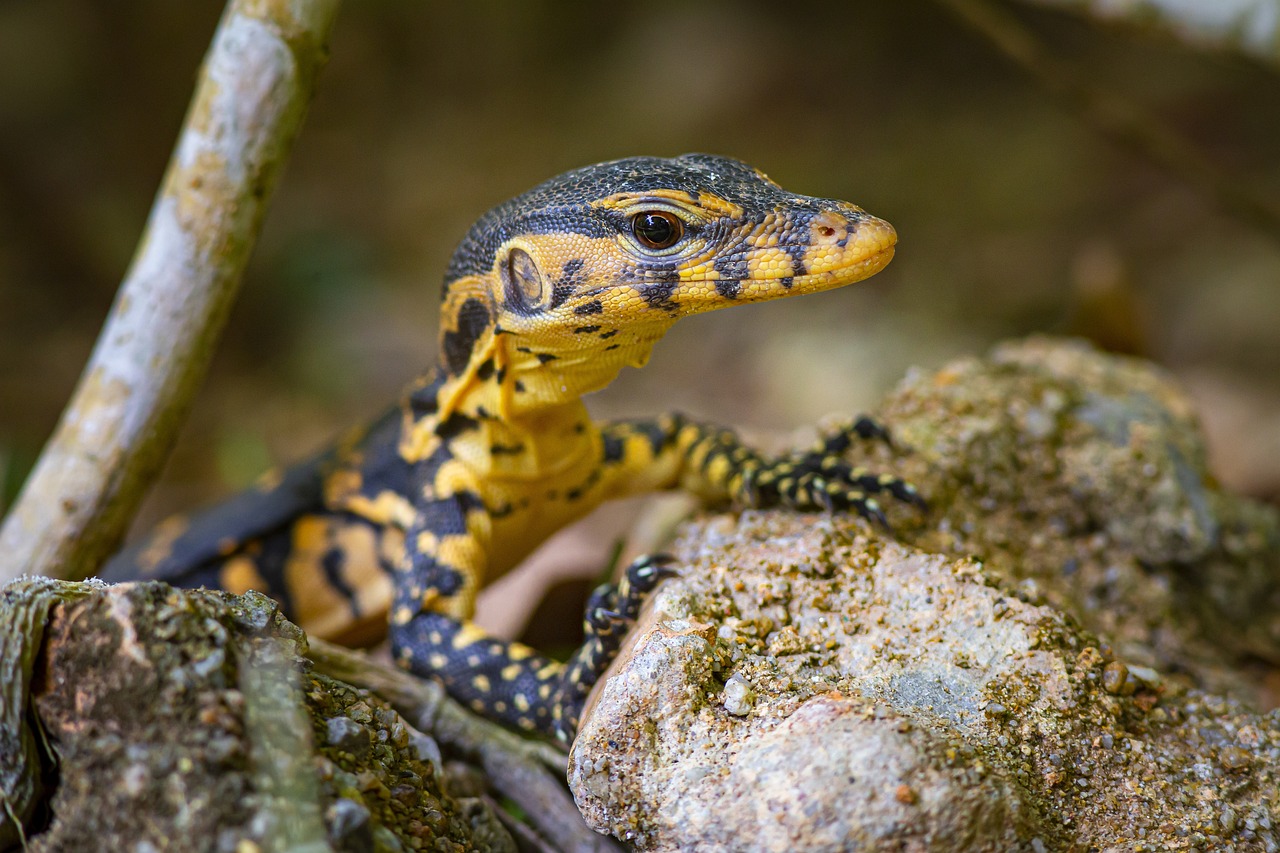This post tells you about all the essentials for keeping your lizard happy and healthy.
Ensure a suitable food source for your lizard’s species
Please check the nutritional requirements of your pet carefully or contact us for advice. Juvenile lizards need more protein than adults and diets may change with age. Adult Bearded Dragons should have a diet of over 85% vegetation, whilst younger individuals should have around 90% insects. Green iguanas are strict vegetarians and feeding protein sources such as chicken and crab sticks can be extremely detrimental to their health.
Food should ideally be dispersed to encourage foraging, but please ensure any bowls used are cleaned thoroughly with a quaternary ammonium compound.
A supply of vitamins and minerals
These should include calcium and may be given either by gut loading insects, dusting food, or providing powders in a bowl for your pet to lick. Ensure your pet does receive these supplements in one form or another to avoid profound ill health developing over time.
A water source must be available and should be large enough for your pet to sit in, if desired.
Not all lizards will drink – the majority of their fluid intake may come from their diet – but they should have the facility to do so, if desired. Water soaks will also help with shedding. Water baths should be appropriate to species type (fresh water, brackish water etc) – please contact us for more information on this. Arboreal species may drink from branches and may need regular spraying or a dripper system.
Vivariums or enclosures
These should be large enough to provide a heat and humidity gradient. There should be room to allow your pet to move around, and they must have adequate ventilation. Substrates vary widely and many are suitable, but please check any wood chips used are not toxic for your pet. For more information or to chat about options, please do not hesitate to contact us. Housing areas should be cleaned thoroughly with a quaternary ammonium compound on a regular basis. Arboreal species will need height as well as floor space.
Space to exercise
Lizards are often very active individuals and may travel large distances on a daily basis in the wild, so exercise is extremely important. If the vivarium is not large enough to allow exercise, provisions should be made for supervised exercise sessions in warm areas elsewhere on a daily basis.
Environmental enrichment
Hides are essential for your pet to allow them to relax and feel secure. Try to make the vivarium environment as close to the natural environment as possible. Sphagnum moss may be useful to help with shedding.
Heat must be supplied and thermometers fitted to ensure a correct gradient is maintained.
Bulbs must be covered with a guard to prevent your pet from sustaining thermal burns. Heated rocks can easily cause burns if not on a thermostat and may be best avoided. If using heat mats, fit them in an appropriate place for the species (on the wall for arboreal species or on the floor for ground-dwellers) and ideally use thermostats. A hot spot should be available at one end of the vivarium under the heat bulb, with the opposite end of the vivarium offering cooler climbs. Heat and light sources should be separate to allow heating without lighting the area over night. Not all species are blind to infra-red light.
Ultraviolet light should be provided for all species.
The role of ultraviolet light in reptile health is largely unknown, but it is essential in diurnal species to allow calcium uptake from the diet and production within the body. We fully corroborate natural environments wherever possible. This means exposing your pet to UV light during the day, even if it is a nocturnal species. Bulbs should be replaced every 6 months and should be covered with a guard and a reflector to prevent thermal burns to your pet and damage to your eyes. Bulbs should be of the correct intensity for your pet’s species environment, and should be separate from the heat source.
UV light should be available whilst your pet is eating and digesting (for diurnal species). Bulbs must be placed at a position above your pet so that the beams shine down (like sunlight). If the bulb is too close to your pet’s line of vision and shines into their eyes, blindness may eventually result – it would be like staring at the sun for a long period of time.
A humidity gradient must be maintained that is appropriate for your pet’s species.
Desert species need very little moisture whilst tropical species must not dry out. Fitting hygrometers at both ends of the vivarium will allow monitoring of the gradient. Sphagnum moss may be useful in providing an area of higher humidity – please contact us for more information.
Ventilation
This is absolutely essential for the health of any lizard, and poor ventilation is frequently the cause of respiratory infection. Ventilation is not, however, to be confused with air movement. Adding a fan to the room will not improve the ventilation, it will simply push contaminated air around the room! A source of fresh air should be supplied without compromising the heat or humidity gradients. Please contact us for more information.
Safety from predators, including your pets, at all times.
Never leave your dog or cat with your lizard when unsupervised: it will only take one slip-up for your dog or cat to kill a small lizard, and large species such as iguanas and monitors can inflict severe damage on your dog or cat!
Regular health care
We recommend six monthly check-ups for all species to keep up-to-date with their general health. Lizards hide any signs of ill health until they cannot keep going any longer, so if you notice any change in your pet, please bring them for a check-up as soon as possible.


